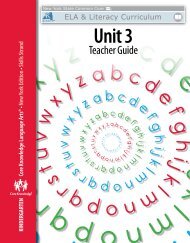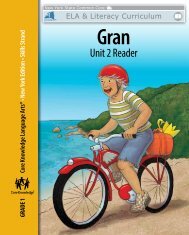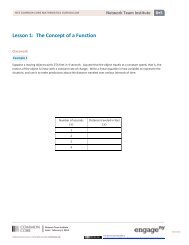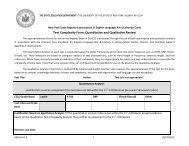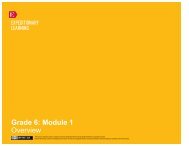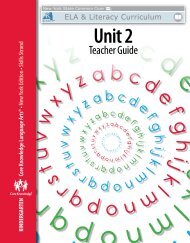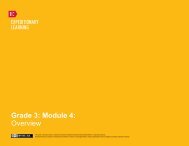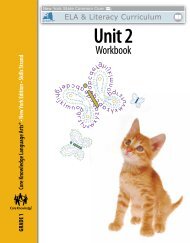Skills Unit 2 Teacher Guide - EngageNY
Skills Unit 2 Teacher Guide - EngageNY
Skills Unit 2 Teacher Guide - EngageNY
Create successful ePaper yourself
Turn your PDF publications into a flip-book with our unique Google optimized e-Paper software.
Tricky Word: who<br />
• Tricky: The letter ‘o’ is pronounced /oo/ (as in the Tricky Words do and<br />
to).<br />
• Place these Tricky Words on your Tricky Word wall.<br />
• After introducing the new Tricky Words, play a Tricky Word game using the<br />
word wall. A suggestion is to play a game called “I Spy the Word.” Give clues<br />
for a specific word and have students guess the word.<br />
Grammar<br />
Review of Quotation Marks<br />
20 minutes<br />
• Tell students there are special punctuation marks we use when writing to<br />
show a person is speaking (in a story when people are speaking we call this<br />
dialogue). Tell students this type of punctuation is called quotation marks. Tell<br />
the class you will discuss how to use quotation marks today.<br />
• Draw a stick figure with a speech bubble on the board like the one shown in<br />
the margin.<br />
• Select a student and have him/her come to the front of the room where you<br />
have written the speech bubble. Write the student’s name (for purpose of<br />
demonstration, we will use the name Mike) above the speech bubble. Ask<br />
Mike “What do you like to eat?”<br />
• Encourage the student, Mike, to restate the question and answer using<br />
complete sentence (e.g., “I like to eat candy.”).<br />
• Explain that speech bubbles are used to show the words a person says or<br />
said. Write I like to eat candy. in the speech bubble.<br />
• Explain you will now write what Mike has said as a sentence. To show exactly<br />
what Mike has said when you write it in a sentence, explain to students that<br />
you will use quotation marks.<br />
• Write Mike said, explaining the comma tells us to pause and the comma<br />
comes before the quotation marks. Then write “I like to eat candy.” Point to<br />
the quotation marks, and explain that these show us exactly what Mike said.<br />
Explain to students the end punctuation is inside of the quotation marks.<br />
Point out both the start of the first letter of the sentence and first word in<br />
quotation marks is also capitalized.<br />
• Ask Mike to give his answer again, this time cupping both his hands around<br />
his mouth as he speaks. Explain that cupping both your hands around your<br />
mouth is just like adding quotation marks in a written sentence. Quotation<br />
marks show the reader exactly what a person has said during a conversation<br />
or dialogue.<br />
48 <strong>Unit</strong> 2 | Lesson 4<br />
© 2013 Core Knowledge Foundation



